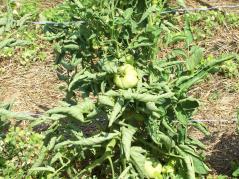FOR IMMEDIATE RELEASE
News Source: Andrew Holsinger, 217-532-3941
URBANA, Ill. – Tomatoes are a warm-season crop that can be adversely affected by excessive heat, said a University of Illinois Extension horticulture educator.
“Temperatures that rise above 92 degrees during ripening can cause reduced fruit flavor, color, and texture,” said Andrew Holsinger.
Because excessive heat is difficult to avoid, Holsinger explained that variety selection can be an important strategy in the fight for good fruit. “Proper cultural practices can help tomatoes tolerate the heat and produce a more bountiful harvest,” he said.
Tomatoes are usually pruned to provide good vine growth and structure when they are of an indeterminate growth habit. Holsinger said pruning should be done when shoots are small to avoid severe pruning. Removal of pruned shoots and culled fruits can benefit the health of your tomatoes by preventing disease, he pointed out.
“It is very important to know the fruiting habits of tomatoes. Determinate and semi-determinate varieties will not need to be pruned with the exception of all suckers (growth found between the main stem and the leaf) below the first flower cluster,” Holsinger noted.
Proper pruning allows for adequate light and air penetration. Another method of increasing air circulation is allowing for adequate spacing of the plants. Plants that are spaced too closely are prone to disease.
Maintaining consistent and even watering to ensure adequate soil moisture (approximately 1 inch per week during the growing season) is advised for a variety of reasons, Holsinger said. Proper soil moisture can help reduce the effects of blossom end rot—a condition caused by a deficiency of moisture and calcium to developing fruits.
Physiological leaf roll is another condition that is especially evident with persistent hot and dry weather. “Indicators of physiological leaf roll are an upward cupping of the leaves that progress to an inward rolling of the leaves. Usually the lower leaves are first affected and then the condition progresses up the plant. This condition, however, has not been shown to affect yield,” Holsinger said.
Red color in tomato fruit does not form when temperatures are above 86 degrees. When temperatures rise above 90 degrees, another physiological condition called yellow shoulder can occur. This condition causes yellow or green tissue under the peel of uniform ripening tomato fruit.
“Mulching is a beneficial practice that can help conserve moisture and moderate soil temperatures. Cultural practices that are started early allow for benefits later in the season,” Holsinger noted.
“Optimal growth and fruiting is provided by optimal environmental and cultural conditions. Extreme growing conditions, such as excessive heat, can be somewhat counteracted with precaution and the practice of protecting the fruit by providing shading or evaporative cooling. Using shade cloth above tomatoes can reduce solar radiation and provide a cooler environment,” he added.
Pull date: November 30, 2022
